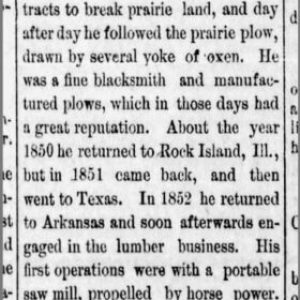calsfoundation@cals.org
Van Winkle's Mill
Van Winkle’s Mill was a series of gristmills and sawmills operated by Peter Van Winkle near Rogers (Benton County) before and after the Civil War. The Van Winkle Mill Site, which became part of Hobbs State Park-Conservation Area, was listed on the National Register of Historic Places on November 15, 2007.
Peter Van Winkle was born on February 25, 1814, in New York City. He purchased land in Washington County in 1835 and, by 1850, was in business as a farmer, blacksmith, and wagon maker. Within a year, he had established a mill in Benton County. His first mill was powered by oxen and then by horses, and in 1856 he moved his operation to Van Hollow and used a steam engine as a power source.
By 1860, Van Winkle, his wife Temperance Miller Van Winkle, and their eight children were living near the mill in a large house; they possessed eighteen enslaved people, which archeologist Jamie C. Brandon termed “not an insubstantial number for Northwest Arkansas, where only the largest slaveholders in the region claimed thirty slaves.”
Van Winkle contracted with the Confederate army in 1861 to build sixteen cabins with wood from his mill at Camp Benjamin, one of a complex of camps at Cross Hollow on the Springfield to Fayetteville Road. When Union troops threatened the area in 1862, the Van Winkles fled with their enslaved people to Bowie County, Texas, remaining there until the war ended. The family’s home and the mill were burned to the ground sometime between 1864 and 1866.
The Van Winkles returned to Arkansas around 1866 and built a new home and an improved mill on the original site; some of the people formerly enslaved by them went to work at the new mill. The mill thrived in the postwar building boom, providing lumber for the rebuilding of Fayetteville (Washington County) and construction of such public buildings as what is now known as Old Main at the University of Arkansas. As the region began to prosper, with new towns at Rogers and Eureka Springs (Carroll County) created, Van Winkle established lumberyards in both towns, purchased timberlands, set up a portable mill in Madison County, and expanded his original mill operation to manufacture doors and windows. Diversifying, he built and opened a three-story hotel on the Fayetteville square in 1880. Van Winkle died suddenly in Rogers on February 10, 1882, and his family arranged for the Frisco Railroad to send a special funeral coach and engine to bring his body to Fayetteville for burial in Evergreen Cemetery.
Van Winkle’s relatives operated the mill for a time after his death, with Aaron “Rock” Van Winkle, Peter Van Winkle’s former slave and, later, principal agent, having facilitated the transition. The steam engine from the mill was sold in 1904, and the flywheel was taken for scrap metal during World War I. The family home was demolished in 1969, before the Arkansas Department of Parks and Tourism acquired the property.
The Van Winkle’s Mill Site has been archeologically excavated more than any other sawmill site in Arkansas, with studies looking into “1) the history of lumber and milling industries and the adoption of steam power, 2) African-American heritage in the Ozarks, Arkansas and the greater South, and 3) the place of the Ozark region in our greater consciousness,” according to the National Register nomination. “Additionally, research has touched upon related issues of race, class, gender, and modernity on both the regional and the national stage.”
The Van Winkle’s Mill Site at Hobbs State Park-Conservation Area can be explored in the twenty-first century through a half-mile walking trail featuring wayside exhibits that describe the site’s history.
For additional information:
Brandon, Jamie C. “Van Winkle’s Mill: Mountain Modernity, Cultural Memory, and Historical Archeology in the Arkansas Ozarks.” PhD diss., University of Texas at Austin, 2004.
———. “Van Winkle’s Mill: Recovering Lost Industrial and African-American Heritage in the Ozarks.” Arkansas Historical Quarterly 67 (Winter 2008): 429–445.
Brandon, Jamie C., and James M. Davidson. “The Landscape of Van Winkle’s Mill: Identity, Myth, and Modernity in the Ozark Uplands.” Historical Archeology 39 (September 2005): 113–131.
Cleek, Katherine. “Van Winkle’s Mill Site.” National Register of Historic Places registration form. On file at Arkansas Historic Preservation Program, Little Rock, Arkansas. Online at http://www.arkansaspreservation.com/National-Register-Listings/PDF/BE3502.nr.pdf (accessed August 1, 2020).
“Historic Van Winkle Trail.” Arkansas State Parks. https://www.arkansasstateparks.com/trails/historic-van-winkle-trail (accessed June 25, 2021).
Huggard, Christopher J., and Jerry Harris Moore. “Rock Van Winkle: Black Builder of Northwest Arkansas.” Arkansas Historical Quarterly 80 (Spring 2021): 1–37.
Mark K. Christ
Central Arkansas Library System
 Historic Preservation
Historic Preservation Louisiana Purchase through Early Statehood, 1803 through 1860
Louisiana Purchase through Early Statehood, 1803 through 1860 Van Winkle Death Story
Van Winkle Death Story 



Comments
No comments on this entry yet.